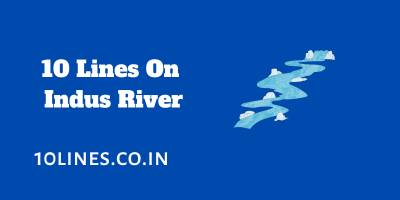10 Lines On Indus River Are you searching for a 10-line essay on the Indus River, one of the major rivers in Asia? Here you will get three different 10-line essays for the Indus River. These three essays are made for students of different categories. Each of them is fed with a lot of information related to the topic.

10 Lines On Indus River For Children And Students
Here you will get a lot of information about the Indus River in different aspects like its origin, length, basin specifications, cities, history, and much more.
Indus is a transboundary river that has its course spread over China, India, and Pakistan. The historical places line Harappa and Mohenjodaro were situated on the bank of the Indus River. The river is most prominent for the people living on the bank of the river and acts as a lifeline for them.
Read the full article, to know about the Indus River in more detail.
Set 1] 10 Lines On The Indus River For Children:
1] The Indus River, which crosses China, India, and Pakistan, is one of the more well-known rivers.
2] The river is referred by a number of different names including Sindhu, Sengge Chu, Abaseen, and Shendu.
3] The Indus River is 2243 miles long overall.
4] It primarily passes through the Indian states of Jammu & Kashmir, Himachal Pradesh, and Punjab.
5] The Indus River’s basin measures about 450,000 square miles.
6] Some of the principal tributaries of the Indus River include the Satluj, Chenab, Beas, Ravi, and Jhelum.
7] Several hydroelectric power plants have been built close to the Indus River.
8] Every year on the day of Guru Purnima, the famous Sindhu Darshan Festival is held in Leh, Ladakh, India.
9] In Rigveda, the Sindhu or Indus River is referred to as being highly auspicious.
10] One of the world’s most endangered cetaceans is the Indus River dolphin, commonly known as the “Bhulan”.
Set 2] 10 Lines On The Indus River For School Students:
1] The Indus River rises at 3927 meters above sea level in Tibet in Tashigang.
2] More than 60% of the total area of the Indus River Basin is made up of Pakistan and PoK.
3] It runs northwest from its point of origin until it reaches Pakistan, where it abruptly switches to a south-westerly direction.
4] Karachi, Peshawar, Gilgit, Attock, and other cities found on the Indus River’s bank.
5] The Indus River originates in the Gar and Senge rivers. In the Tashigang in Tibet, the two rivers combine to form the Indus River.
6] At a length of 2243 miles, the river is the eighth-longest in Asia.
7] The Indus River plain is a vast expanse of agricultural land covering around 200,000 square kilometers.
8] The Indus River is ranked 12th in terms of basin size.
9] The Indus River is vital to Pakistan’s economy since it offers significant water resources.
10] In India, the Indus is designated as a national waterway NW46.
Set 3] 10 Lines On The Indus River For College Students:
1] In Pakistan, the Indus River is regarded as a lifeline for agriculture.
2] The river begins in Tibet in Tashigang and flows into the Arabian Sea near Karachi, Pakistan.
3] It’s a transboundary river that runs through China, Pakistan, and India.
4] The river, which begins with glaciers, sustains the environment of temperate woodlands, grasslands, and dry countryside.
5] With a size of around 41,440 km2, the Indus River Delta is the fifth-largest delta in the world.
6] Some of the crops grown in the Indus Valley include rice, peas, beans, barley, wheat, fruits, and millets.
7] The river is also utilised for transportation, with boats transporting people or goods.
8] The cities of Harappa and MohenjoDaro were built on the banks of the Indus River.
9] A large number of people rely on the Indus River for their livelihood.
10] The Indus River is regarded as one of the world’s most plastic-polluted rivers.
Friends, thank you for reading the River Indus article. We hope you found the information above useful and that you enjoyed reading it. We made an effort to present this information in a simple and easy-to-remember format. This information can be used for project work, homework, exam preparation, and speeches, among other things.